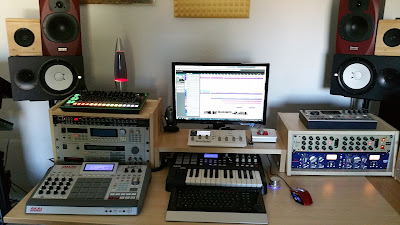MPC
Renaissance
I really like the combination of MPC Renaissance hardware with the MPC 2 software DAW.
During the last updates it has become so much flexibility and still the feeling of a hardware mpc with the awsome pads and knobs. I always loved the 3000er design and the hardware of the Renaissance is feeling pretty solid and high quality.
The original software was really limited and more like a pc version of the orignal mpc os.
With the new MPC DAW you get all the flexibilty of VST's, MIDI and Audio routing what we need in modern production enviroments. For example normally I'm using the MPC Renaissance audio interface with 4 outputs (2x Stereo) routing into my hardware mixer for using some external equipment. If I need more then 4 outputs, I can swap the audio interface for my motu (+3 adats + daisychain) and now I got 40 analog outputs! How amazing is that? You can stay also "ITB" and using software plug-ins as well.
You got 4 MIDI In and Outs and I connected my Akai Samplers S950, S1100 and S3000. For me the timing is really great. And you can simultaneously use all Midi Interfaces. I remember it was not working at some older releases but they fixed that in an update.
I need to say, not everything is perfect and there are still some small bugs with the DAW and some VST's but it's not a big deal. I dont like there is no usefull metering for the mixer and you need take care about audio levels.
Some things are really confusing and maybe different than in other DAW's. So I want show you here some tipps.
1. Recording Audio
Recording audio was really confusing for me! If you got many inputs it's even more confusing. For the case you are using a motu or any other interface with 2 mic preamps, we need to care about that input 1/2 are not the line inputs 1/2 of our interface. They are the mic preamp inputs! So analog 1/2 input of my motu is input 3/4 in the software. 😏
· Create audio track
· Select input: 3 /4 is analog 1 /2
S/PDIF 1-2 is 11/12 (for my interface)
· Go to track and click red dot
· Record
2. MPC Expansion Content
The content
is stored in C:\ProgramData\Akai\MPC\Content
Now we manually
copy the content to another location.
Edit the
file TheBank.txt in C:\ProgramData\Akai\MPC\TheBank
You
delete the path C:/ProgramData/Akai/MPC/Content/TheBank/Samples
And type in
your new one:
H:/Audio Programm Data/Akai/MPC/Content/TheBank/Samples
Important
use the Slash “/” not a backslash “\” and at the end of the path “/Samples”
Otherwise
it won’t work!



